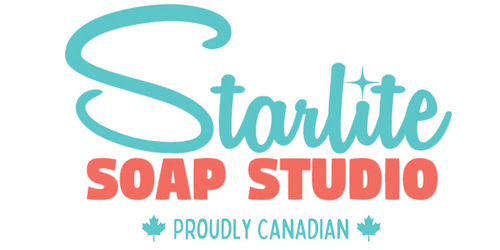Starlite Soap Studio has been teaching cold-process soap making for twelve years, and each workshop imparts all the knowledge, tips and tricks you'll need to create a beautiful, luxurious product in your own kitchen. During the workshop, you will create a 3lb (12-bar) block of your own customized product.
In this blog post, we would like to offer some history! Cold process soap making is a traditional method of creating soap that has been used for centuries. This method involves mixing fats and oils with an alkali solution to create soap. The cold process soap-making technique has been refined and perfected over the years, resulting in the soaps we create and use today.
The origins of cold process soap making can be traced back to ancient Babylon, where the first soaps were made from fats and ashes. The ancient Egyptians and Greeks also made soap using similar techniques. In Europe, soap-making became an important industry during the Middle Ages, with soap makers forming guilds and sharing their knowledge and expertise.
The cold process soap-making technique that we know today was developed in the 18th century. The process involves mixing oils and fats with an alkali solution, which causes a chemical reaction called saponification. This reaction results in the formation of soap and glycerin.
One of the key developments in the history of cold process soap making was the discovery of the role of lye in the process. Lye, properly known as sodium hydroxide, is a caustic substance that is essential to the saponification process. It was originally obtained by burning wood or other organic material, but today it is produced commercially. The sodium hydroxide chemically converts during the saponification process, so that the finished product is kind and gentle to human skin.
In the early 19th century, a French chemist named Michel Chevreul discovered that fats and oils are made up of fatty acids. This discovery led to a better understanding of the chemistry of soap making, and soap makers were able to create soaps with consistent qualities.
During the 20th century, soap-making became an industrial process, with large factories producing soap using a combination of cold and hot process techniques. However, in recent years, there has been a renewed interest in traditional soap-making techniques, and many people are now making their own soap at home using the cold process method.
Today, cold-process soap making is a popular hobby and a thriving industry. Soap makers use a variety of oils and fats, as well as natural colourants and fragrances, to create unique and beautiful soaps. The process of making soap using the cold process method requires careful attention to detail, but the results are well worth the effort.
Let Starlite Soap Studio introduce you to the art and craft of cold-process soap making! Our Beginner’s Soap Making workshop is a fun, informative and interactive workshop during which you will learn everything you need to embark on this exciting (and potentially lucrative!) new pastime.
We hope you will sign up for one of our regular Beginner’s Soap Making Workshops today, or invite your friends to your own Private Group Workshop!

